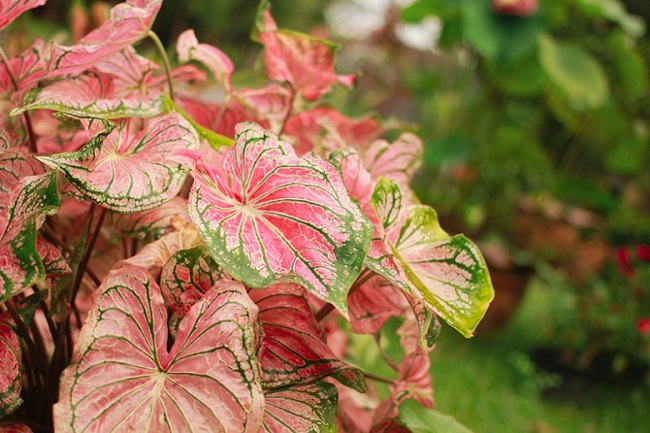
Caladiums, with their vibrant and eye-catching foliage, are beloved plants that add a touch of tropical elegance to any garden or greenhouse. These versatile plants thrive both outdoors as landscape specimens and indoors as container plants in a controlled environment. Whether you’re looking to enhance your garden or create a stunning display in a greenhouse, this article will guide you through the process of successfully growing caladiums in both settings.
Outdoor Landscapes
Step 1: Choosing the Right Location
Select a location in your outdoor landscape that provides indirect or filtered sunlight. Caladiums prefer partial shade or dappled light to prevent scorching of their delicate leaves. Additionally, ensure the soil is well-draining, rich in organic matter, and slightly acidic (pH 5.5 to 6.5). Read this article for information on how to test garden soil for pH and how to correct it.
Step 2: Preparing the Soil
Before planting, prepare the soil by incorporating compost or well-rotted organic matter to improve its fertility and drainage. Caladiums thrive in moist soil, so ensure the planting area retains moisture without becoming waterlogged.
Step 3: Planting the Caladiums
Plant caladium tubers or pre-grown potted caladiums once the soil has warmed up to around 70°F. Dig a hole that is 2 to 3 inches deep and place the tuber with the pointed end facing up. Space the tubers approximately 8 to 12 inches apart to allow for their growth. Gently cover the tubers with soil and water thoroughly.
Step 4: Watering and Maintenance
Keep the soil consistently moist but not saturated, as overly wet conditions can cause tuber rot. Regular watering, especially during dry spells, is essential to support healthy growth. Applying a layer of mulch around the plants will help retain moisture and suppress weed growth. Remove any faded or yellowing leaves to maintain a neat appearance.
Step 5: Fertilizing
Feed your caladiums with a balanced, slow-release fertilizer or a water-soluble fertilizer every four to six weeks throughout the growing season. Follow the package instructions for dosage and application method. This regular feeding will promote vigorous foliage growth and vibrant colors.
Greenhouse Container Plants
Step 1: Selecting Containers
Choose well-draining containers with adequate drainage holes to prevent waterlogging. Select pots that allow for growth and expansion of the caladium tubers, ensuring there is enough space for the roots to spread.
Step 2: Potting Mix and Planting
Use a well-draining, peat-based potting mix that retains moisture without becoming waterlogged. Fill the container about halfway with the potting mix and place the caladium tuber with the pointed end facing up. Cover the tuber with more potting mix, leaving about an inch of space from the rim of the pot. Water thoroughly after planting.
Step 3: Light and Temperature
Place the containers in a greenhouse with bright, indirect light. Caladiums require temperatures between 70°F to 85°F to thrive. Avoid exposing them to direct sunlight, as it can scorch the leaves. Maintain a consistent temperature to support healthy growth.
Step 4: Watering and Humidity
Keep the potting mix consistently moist, but not waterlogged. Water thoroughly when the top inch of soil feels dry. Mist the leaves regularly to increase humidity, as caladiums appreciate higher humidity levels. Placing a tray of water near the containers or using a humidifier can help maintain the desired humidity levels in the greenhouse.
Step 5: Fertilizing
Apply a balanced, water-soluble fertilizer formulated for container plants once every two to four weeks during the growing season. Follow the package instructions for proper dilution and application. Fertilizing helps replenish the nutrients in the potting mix and promotes healthy foliage growth.
Conclusion
Whether you choose to grow caladiums in your outdoor landscape or as container plants in a greenhouse, their stunning foliage and versatility will captivate all who behold them. By following these guidelines, you can cultivate thriving caladiums and enjoy their vibrant beauty throughout the growing season. Remember to provide the ideal light, water, temperature, and nutrient conditions to support their growth, and get ready to be rewarded with an enchanting display of colors and patterns.
Related Articles & Free Email Newsletter Sign Up
Aloe Plants Offer Medicinal Properties and Ornamental Beauty
How to Grow the Coral Cactus Plant
Impatiens are Easy to Grow and Add Vivid Color to Your Yard or Greenhouse




Comment here